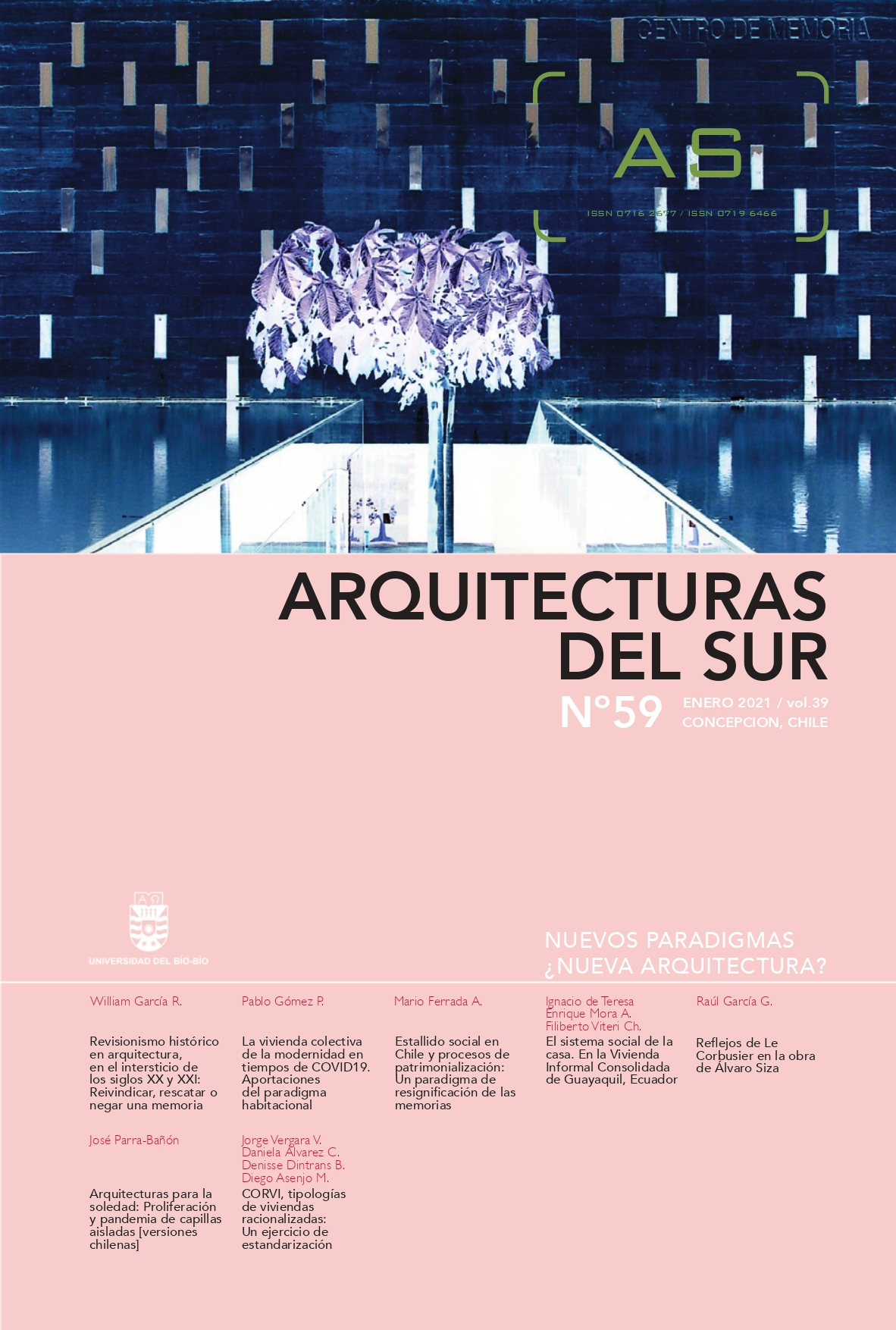Revisionismo histórico na arquitetura no interstício dos séculos XX e XXI: reivindicar, resgatar ou negar uma memória
DOI:
https://doi.org/10.22320/07196466.2021.39.059.01Palavras-chave:
Revisionismo histórico, crítica da arquitetura, demolição, história da arquitetura, memóriaResumo
O revisionismo histórico, fenômeno típico das ciências sociais e políticas, vem se consolidando no início do século XXI como uma das estratégias paradigmáticas da arquitetura, com o propósito de reescrever (ou apagar) memórias históricas da cidade. Nesse contexto, o objetivo da pesquisa aqui apresentada foi investigar a relação entre diferentes conjunturas sociais e políticas convergentes sobre o tema da memória e a demolição / construção de arquiteturas como estratégia para interrogar acontecimentos do passado e questionar narrativas oficiais. Por se tratar de uma pesquisa historiográfica, a metodologia baseou-se no cruzamento dos discursos com os quais têm sido discutidos diversos problemas sociopolíticos em torno da memória, ocorridos em vários países, com os projetos arquitetônicos construídos ou demolidos como consequência desses debates. As conclusões, como contribuição da pesquisa, permitiram detectar três tendências do revisionismo histórico na arquitetura, a partir de seu uso (e abuso) no que tange à historiografia dos fatos: reivindicação, resgate e negação da memória.
Downloads
Referências
AGUILAR-FORERO, N. (2018). Políticas de la memoria en Colombia: iniciativas, tensiones y experiencias (2005-2016). Historia Crítica, (68), 111-130.
BBC Mundo (17 octubre 2016). Austria anuncia que la casa de Hitler será demolida. Recuperado de: https://www.bbc.com/mundo/noticias-internacional-37683525
BURCHARD, W. (2016). What’s the point of rebuilding Germany’s palaces? Apollo Art Magazine. Recuperado de https://www.apollo-magazine.com/whats-the-point-of-rebuilding-germanys-palaces/
CAPITEL, A. (1997). Arquitectura europea y americana después de las vanguardias. La arquitectura revisionista y orgánica en Estados Unidos. Madrid: Espasa Calpe.
CHIARAMONTE, J. (2013). Usos políticos de la historia. Lenguaje de clases y revisionismo histórico. Buenos Aires: Sudamericana.
ERLL, A. (2012). Memoria colectiva y culturas del recuerdo estudio introductorio. Bogotá: Uniandes.
FERNÁNDEZ GALIANO, L. (2009). La diferencia indiferente. AV: Monografías, (139), 3-5.
Fundación Rogelio Salmona (2001). Recuperación del eje ambiental avenida Jiménez de Quesada. Recuperado de http://obra.fundacionrogeliosalmona.org/obra/proyecto/recuperacion-del-eje-ambiental-avenida-jimenez-de-quesada/
GORELIK, A. (31 agosto 2009). Arquitectura y Memoria. Memoria abierta. Actas Jornada Arquitectura y Memoria (pp. 16-23), Buenos Aires, Argentina. Recuperado de http://memoriaabierta.org.ar/wp/wp-content/uploads/2018/07/Arquitectura-y-Memoria-Memoria-Abierta.pdf
Gobierno de España (2007). Ley de la memoria histórica. Ley 52/2007 por la que se reconocen y amplían derechos y se establecen medidas en favor de quienes padecieron persecución o violencia durante la guerra civil y la dictadura. Madrid.
Infobae (15 diciembre 2016). Finalmente, Austria expropiará la casa natal de Adolf Hitler, pero no la demolerá. Recuperado de https://www.infobae.com/america/mundo/2016/12/15/finalmente-austria-expropiara-la-casa-natal-de-adolf-hitler-pero-no-la-demolera/ (2016)
JARAMILLO, J. Y DEL CAIRO, C. (2013). Los dilemas de la museificación. Reflexiones en torno a dos iniciativas estatales de construcción de memoria colectiva en Colombia. Memoria y Sociedad, 17(35), 76-92.
KLEIN, N. (2010). ¿Dónde queda el olvido? Una nota acerca del padre de Borges. En Plot, M. (comp.), Destino sudamericano (pp. 209 -216). Buenos Aires: Teseo.
LANDSBERG, T. (2 julio 2020). La casa natal de Hitler se convertirá en una comisaría de Policía. DW. Recuperado de https://www.dw.com/es/la-casa-natal-de-hitler-se-convertir%C3%A1-en-una-comisar%C3%ADa-de-polic%C3%ADa/a-54019844
LUTHAR, O. (2013). Forgetting does (not) hurt. Historical Revisionism in Post-Socialist Slovenia. Nationalities Papers, 41(6), 882-892.
MARTÍN BARBERO, J. (2010). Mutaciones culturales y estéticas de la política. Revista de Estudios Sociales, (35), 15-25.
MONTANER, J. Y MUXI, Z. (2011). Arquitectura y política. Ensayos para mundos alternativos. Madrid: Gustavo Gili.
MORRILL, J. (2015). Revisionism's Wounded Legacies. Huntington Library Quarterly, 78(4), 577-594. Recuperado de http://www.jstor.org/stable/10.1525/hlq.2015.78.4.577
Museo Reina Sofía - Subtramas. Abecedario anagramático. Recuperado de http://subtramas.museoreinasofia.es/es/anagrama/agenciamiento
Sociedad Colombiana de Arquitectos (2018). Bases. Concurso público internacional anteproyecto arquitectónico para el diseño de un Espacio de memoria y reflexión, Medellín 1983 – 1994. Bogotá.
Taller Síntesis (2018). Memoria descriptiva. Concurso público internacional de anteproyecto arquitectónico para el diseño de un Espacio de memoria y reflexión, Medellín 1983 – 1994. Plancha 1 de 2. Recuperado de https://www.archdaily.co/co/908185/esta-es-la-propuesta-de-taller-sintesis-para-el-edificio-monaco-en-medellin
VON HENNEBERG, K. (2004). Monuments, Public Space, and the memory of Empire in Modern Italy. History and Memory, 16(1), 37-85.
Downloads
Publicado
Como Citar
Edição
Secção
Licença
Direitos de Autor (c) 2021 Wiliam García-Ramirez

Este trabalho encontra-se publicado com a Licença Internacional Creative Commons Atribuição-CompartilhaIgual 4.0.

O conteúdo dos artigos publicados em cada número da Arquitectura del Sur, é de responsabilidade exclusiva dos autores e não representam necessariamente o pensamento, ou compartem a opinião da Universidade de Bío-Bío. Os autores têm seus direitos autorais conservados, e garantiram à revista o direito de primeira publicação e difusão de sua obra. A publicação do artigo na Arquitectura del Sur estará sujeita à Licencia de Reconocimiento de Creative Commons CC BY-SA isso permite que outros se Adaptem: remixam, transformam e constroem o material para qualquer finalidade, inclusive comercialmente, Compartilhe: copie e redistribua o material em qualquer meio ou formato, desde que a autoria e a primeira publicação desta revista sejam reconhecidas, citando-a corretamente , bem como suas novas criações estão sob uma licença com os mesmos termos.













 Programa de Información Científica/Concurso Fondos de Publicación de Revistas Científicas 2018/ Proyecto Mejoramiento de Visibilidad de Revistas UBB (Código:FP180007)
Programa de Información Científica/Concurso Fondos de Publicación de Revistas Científicas 2018/ Proyecto Mejoramiento de Visibilidad de Revistas UBB (Código:FP180007) 
